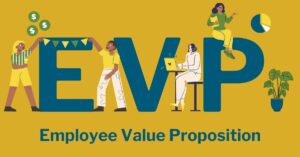By the KMA Team
 In the current tight labor market, employers are considering the many ways they can attract and retain employees. In addition to identifying strategic talent acquisition approaches to source candidates and evaluating the competitiveness of base pay, employers can also review and reconsider their entire offerings to employees and create their own Employee Value Proposition (EVP).
In the current tight labor market, employers are considering the many ways they can attract and retain employees. In addition to identifying strategic talent acquisition approaches to source candidates and evaluating the competitiveness of base pay, employers can also review and reconsider their entire offerings to employees and create their own Employee Value Proposition (EVP).
What is an EVP and why is it important for employers?
An EVP represents everything of value employers provide to their employees in return for their time, skills and efforts. It represents a company’s culture and what sets it apart from other employers. The elements of an EVP include financial incentives: base pay, variable pay, and equity; traditional employee benefit packages; employee development tracks; well-being programs; retirement plans; and other company perks and work lifestyle opportunities for employees. Once you identify everything of value provided to employees, you can develop a compelling EVP that showcases these offerings and serves as a valuable tool to help attract and retain employees.
Here are five steps to create and communicate an EVP that is meaningful and attractive to your current and future employees.
1. Identify All Your Current Offerings of Value to Employees
As employers go through the process of identifying value items, they should consider the entire employee experience and components that have both financial and non-financial value. This includes types of employee benefits that are often not included on summaries of compensation and benefits provided to job candidates and employees. Many employers offer other items beyond typical benefits, including: career and professional development, mentoring, health and wellness, gym memberships, flexible and remote work schedules, on-site services, support for volunteer and pay it forward activities, company events, and other perks that may be highly attractive to employees. Many of these have a dollar value, and others, such as an opportunity to participate in a giving back experience or mentoring program, provide an intrinsic value which can make the workplace and company culture more attractive to individuals.
2. Evaluate the Competitiveness of Your Offerings
Before developing an EVP, you should first examine the benefits marketplace and how competitive your current offerings are in comparison. This can be useful in creating a more robust rewards program by shoring up existing benefits and adding others that are typically provided by most employers. For a reliable competitive analysis, it is important to look at data from trusted survey sources in the marketplace from which you recruit and hire employees.
3. Consider Employee Demographics and Trends
As our workforce and employee demographics change, the benefits and other rewards your employees and future hires want most also evolves. While consistency in offerings is important, the current trend is towards customization to meet employees where they are in their career and life stage. Some employees may value tuition assistance or student loan benefits, and others may be more interested in work/life balance, including flexible work schedules and time off, more cash in their pocket now, or retirement benefits for the future. Employers should consider offerings that appeal to the employee as they move through their career and stage of life. For example, an employer could offer benefits for student debt repayment and college savings, or lifestyle accounts with funds employees can utilize for a variety of nontraditional wellness and household needs.
4. Obtain Data on Employee Needs and Interests
To learn what is meaningful to include in your EVP, go right to the source and ask employees what is important to them. Employee surveys and stay or exit interviews can provide data on the value of existing offerings, and others that employees would like to see offered or enhanced. Examining the utilization rates of existing benefit programs can also help determine where to shift benefits and rewards dollars, and which benefits and programs to retain or add.
5. Develop and Communicate Your EVP
The EVP is an important part of your long term employer branding strategy It can help you communicate your mission and company values, and highlight what sets you apart as an employer. If giving back and sustainable practices are part of your employer brand, your EVP can highlight opportunities employees have to participate in these initiatives and how your company contributes. However you communicate it – via document, slide presentation, video, etc. – it should be consistent with your brand voice and visual guidelines. Once your EVP is developed, broadcast it across the organization so employees at all levels are aware and can help share the message, and make sure to include it in your recruiting process. Your EVP is an invaluable tool for educating your current and future employees on the benefits, rewards, and experiences your organization offers.
By following this five-step strategic approach to developing and communicating your Employee Value Proposition (EVP), you can be more competitive in talent acquisition, and engaging and retaining the talent you’ve already got.
If you would like help examining your total employee offerings and developing or refining your EVP, reach out to the compensation experts at KMA today.
